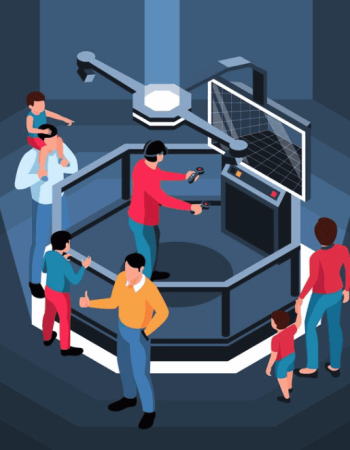Audiovisual installations have long captivated audiences with their immersive blend of sight and sound, creating experiences that transcend traditional art forms. As technology continues to evolve at a rapid pace, the future of audiovisual installations promises even more groundbreaking innovations. In this blog, we will explore the emerging trends set to redefine this dynamic art form, blending creativity with cutting-edge technology to deliver awe-inspiring experiences.
1. Immersive Virtual Reality Experiences
Virtual reality (VR) is poised to revolutionize the realm of audiovisual installations. Artists are increasingly utilizing VR to create fully immersive environments where viewers can interact with digital art in three dimensions. Unlike traditional installations, which viewers passively observe, VR allows them to become an integral part of the artwork. This trend is not just about seeing and hearing but also feeling like one is inside the piece, providing a multi-sensory experience that is deeply engaging and highly personalized.
2. Augmented Reality Enhancements
While VR creates entirely new worlds, augmented reality (AR) overlays digital elements onto the real world. This technology is being harnessed by artists to enhance physical spaces with virtual components. Imagine walking through a city park where digital sculptures appear through your AR glasses or a gallery where the artworks come to life with animation and sound. AR is bridging the gap between the physical and digital, making art more accessible and interactive.
3. Artificial Intelligence and Machine Learning
Artificial intelligence (AI) and machine learning are becoming integral to the creation of audio-visual installations. These technologies enable the creation of dynamic, responsive art that evolves based on viewer interaction. AI can analyze data in real-time to modify visual and auditory elements, creating a personalized experience for each visitor. This interactivity not only makes the installation more engaging but also allows for a deeper connection between the artwork and its audience.
4. Interactive Installations and User Participation
Future audiovisual installations will place a stronger emphasis on interactivity, inviting viewers to participate actively in the art. This trend is fueled by advancements in sensor technology and interactive software. Motion sensors, touch screens, and voice recognition are being used to create installations that respond to the movements, touch, and speech of viewers. This level of interactivity transforms the audience from passive observers into active participants, making each visit unique and memorable.
Also Read: Lights, Camera, Action! The Impact of Audio-Visual Installation on Presentations
5. Biometric Feedback Integration
Incorporating biometric feedback is another fascinating trend on the horizon. Artists are beginning to use data from heart rate monitors, brainwave sensors, and other biometric devices to influence the audiovisual elements of their installations. For instance, an installation might change its visual and auditory output based on the viewer’s emotional state, creating a deeply personalized and emotionally resonant experience.
6. Sustainable and Eco-Friendly Art
As environmental concerns become more pressing, sustainability in art is gaining traction. Audiovisual installations are increasingly being designed with eco-friendly materials and energy-efficient technologies. Solar-powered installations, recycled materials, and biodegradable components are becoming more common. Additionally, some artists are using their installations to highlight environmental issues, raising awareness and encouraging eco-friendly practices among their audiences.
7. Cross-Disciplinary Collaborations
The future of audiovisual installations will see more collaborations between artists, musicians, technologists, and scientists. These cross-disciplinary partnerships are driving innovation, combining diverse expertise to create richer, more complex installations. For example, a collaboration between a visual artist, a composer, and a computer scientist could result in an installation where visuals and sounds are generated in real time based on complex algorithms and data inputs.
8. Portable and Pop-Up Installations
Flexibility and mobility are becoming key trends, with artists creating portable and pop-up installations that can be easily transported and set up in various locations. These installations bring art to unexpected places, from urban street corners to remote natural landscapes, making art more accessible to a wider audience. The transient nature of these installations also adds an element of surprise and spontaneity, attracting new and diverse audiences.
9. Multi-Sensory Experiences
Future audiovisual installations will increasingly engage all the senses, not just sight and sound. Artists are incorporating elements like scent, touch, and even taste to create fully immersive experiences. For instance, an installation might use scent diffusers to release fragrances that complement the visual and auditory components or haptic feedback devices to provide tactile sensations. These multi-sensory experiences create a deeper level of immersion and engagement, leaving a lasting impression on the viewer.
10. Data-Driven Art
Data is becoming a powerful tool for artists, who are using it to inform and shape their installations. Data-driven art can visualize complex datasets, making abstract concepts more tangible and understandable. Artists are using real-time data from sources like social media, environmental sensors, and public databases to create installations that reflect current events, societal trends, or environmental conditions. This approach not only adds a layer of relevance and immediacy to the art but also encourages viewers to engage with important issues in new and thought-provoking ways.
Conclusion
The future of audiovisual installations is incredibly exciting, as technological advancements and creative innovation continue to push the boundaries of what is possible. From immersive VR and AR experiences to AI-driven interactivity and multi-sensory engagement, the next generation of audio-visual installations will offer deeper, more personalized, and more impactful experiences. As artists continue to explore new tools and techniques, audio-visual installations will undoubtedly remain at the forefront of contemporary art, captivating and inspiring audiences around the world. Whether you are an artist, a technologist, or an art enthusiast, the evolving landscape of audiovisual installations promises a wealth of inspiration and wonder.




